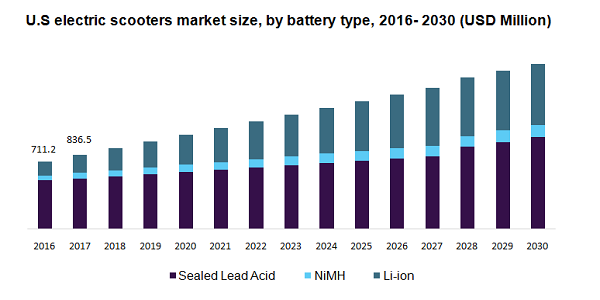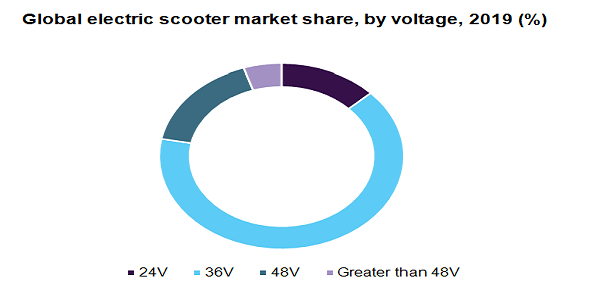- US: +1-408-610-2300
- Toll Free: +1-866-831-4085
- Become a Client
The global electric scooters market size was accounted for USD 18.6 billion in 2019. Factors such as depleting energy non-renewable energy sources and increasing concern regarding the emission of greenhouse gases are driving the demand for electric scooters. In addition, electric scooters require low maintenance and it has high mechanical efficiency, regenerative braking, and reduced noise. These factors encourage customers to choose these vehicles over traditional scooters.
Electric scooters are being increasingly used as sharing services in countries such as Germany, France, the U.S, and Spain. Owing to this, these countries are witnessing a significant demand for battery-powered two-wheelers. Companies like Jump, Bird, Lime, Spin, and Razor procure vehicles from original equipment manufacturers such as Ninebot-Segway, Xiaomi, and Gogoro, Inc. among others. Sharing services are gaining traction since 2016. Growing adoption led to the use of electric drivetrains in over 90 cities along with various educational institutions.

Government across the globe is encouraging manufacturers to increase production by providing monetary support. Moreover, increasing focus on sustainable transportation solutions is further supplementing the market growth. Environment protection and climate change have become the major concern owing to the growing air pollution from internal combustion engine vehicles. While penetration of e-scooters is projected to improve the air quality and energy security.
Several countries planned to achieve the target of zero emission by 2020. This has led to a rise in partnerships between manufacturers and the government. E-scooters are known to consume moderate electricity that can be managed with proper planning. Further, with the advent of vehicle to grid technology and solar-powered vehicles, e-scooter electric consumption can be managed easily.
Governments worldwide are not supporting financial aid but they are providing the necessary infrastructure to encourage research and development. For example, the Corporate Average Fuel Economy (CAFÉ) of the United States is focusing on increasing the adoption of electrically operated automobiles by framing favorable regulations. Similarly, the government of Canada is aiming to achieve zero emission by adopting electric vehicles for various applications.
Depending on the product, the electric scooter market is categorized into retro scooters and standing/self-balancing and folding. Of them, the retro segment accounted for the highest share in the market in 2019 owing to the growing preferences for greener vehicles for short-distance commuting. This has led to a significant reduction in the overall cost of commuting. However, millennials in developed countries are increasingly adopting lightweight and convenient vehicles that have a minimal operating cost.
On the other hand, the folding segment is projected to register over 10.0% CAGR from 2020 to 2030. The emergence of smart scooters integrated with IoT and big data is attributing to the growth of this segment. Besides, standing/self-balancing e-scooters are likely to witnesses increased adoption from residential and commercial applications.
Based on the battery, the e-scooters market is classified into Sealed Lead Acid (SLA) Nickel Metal Hydride (NIMH), and Lithium-Ion (Li-ion). In 2019, the SLA segment held the highest share in the market due to advantages such as low cost, high tolerance to abuse, and robustness. However, over the next few years, the demand for SLA batteries is anticipated to decline owing to their bulky size and ability to drain rapidly.
On the other hand, Li-ion battery is projected to grow at over 10% CAGR from 2020 to 2030. The growth is due to the significant price reduction of these batteries. It is projected that the price of these batteries would reduce by over 70% by the end of 2030. Due to this price reduction, the overall cost of electric scooters would also decrease significantly, thereby, positively driving the market growth. Li-ion batteries are light in weight and offer high charge density.
Depending on the voltage, the market is classified into >48V, 48V, 36V, and 24V. Of them, the 36V segment held over 62% share in the market in 2019. 36V batteries are not only highly compatible with e-scooters but they also offer better power output. Owing to these factors, these batteries are predicted to witness considerable growth over the next ten years.

However, batteries with 48V are also witnessing significant demand owing to the increasing preferences among consumers to have longer battery life. On the other hand, batteries with over 48V are likely to register more than 11% CAGR from 2020 to 2030. Owing to the increasing focus on improving the performance and speed of e-scooters, batteries with 60V and 70V are anticipated to gain traction over the next few years.
In 2019, Asia Pacific was worth 13.9 billion by value in the overall market. Over the past few years, there has been a rise in the number of e-scooters manufacturers in countries such as China, Japan, and Taiwan. China is the leading producer, consumer, and exporter of electric scooters. Key players operating in China are Zhejiang Luyuan, Yadea, Vehicle Co., Ltd¸ Niu International, and Vehicle Co., Ltd among others.
On the other hand, it is projected that North America would register the highest CAGR of over 13% over the forecast duration. Factors such as increasing support from government and electric vehicle charging infrastructure are attributing to the growth of the region. Manufacturers are introducing different models to attract young customers in the region.
COVID-19 outbreak has forced people to stay at their homes leading to a significant decline in road traffic. Owing to the reduced road traffic, the demand for e-scooters has taken a hit, thereby, adversely affecting the market growth. In addition, supply chain disruption has resulted in a lack of availability of raw materials for production. Moreover, manufacturers have reduced their spending on research and development amid low demand.
However, China, which is a major market for e-scooters, has allowed economical activities. Several other countries are following similar suits. Therefore, the market is estimated to recover after the short-term decline due to the pandemic.
Key market players are BMW Motorrad International, Terra Motors Corporation, Mahindra GenZe, and Gogoro Inc. among others. Besides, companies such as Bird Rides, Govecs AG, and Lime are focusing on introducing rental services to increase the penetration of e-scooters. On the other hand, Chinese players are focusing on increasing their investment in research and development to introduce cost-effective and high-performance e-scooters. In Taiwan, the introduction of swappable battery scooters by Gogoro has been a huge success. Major Japanese players operating in the market are Kawasaki, Honda, Suzuki, and Yamaha.
|
Report Attribute |
Details |
|
The market size value in 2020 |
USD 20.0 billion |
|
The revenue forecast in 2030 |
USD 42.0 billion |
|
Growth Rate |
CAGR of 7.7% from 2020 to 2030 |
|
The base year for estimation |
2019 |
|
Historical data |
2016 - 2018 |
|
Forecast period |
2020 - 2030 |
|
Quantitative units |
Revenue in USD million/billion and CAGR from 2020 to 2030 |
|
Report coverage |
Revenue forecast, company ranking, competitive landscape, growth factors, and trends |
|
Segments covered |
Product, battery, voltage, region |
|
Regional scope |
North America; Europe; Asia Pacific; Latin America; Middle East & Africa |
|
Country scope |
U.S.; Canada; Mexico; Germany; France; China; India; Japan; Brazil |
|
Key companies profiled |
Mahindra GenZe; BMW Motorrad International; Vmoto Limited; Terra Motors Corporation; Gogoro Inc.; Jiangsu Xinri Electric Vehicle Co. Ltd. |
|
Customization scope |
Free report customization (equivalent up to 8 analysts working days) with purchase. Addition or alteration to country, regional & segment scope. |
This report forecasts revenue growth at global, regional, and country levels, and provides an analysis of the latest industry trends in each of the sub-segments from 2016 to 2030. For the purpose of this study, Million Insights has segmented the global electric scooters market report based on product, battery, voltage, and region:
• Product Type (Revenue, USD Million, 2016 - 2030)
• Retro
• Standing/Self-Balancing
• Folding
• Battery Type (Revenue, USD Million, 2016 - 2030)
• Sealed Lead Acid
• NiMH
• Li-Ion
• Voltage Type (Revenue, USD Million, 2016 - 2030)
• 24V
• 36V
• 48V
• Greater than 48V
• Regional Outlook (Revenue, USD Million, 2016 - 2030)
• North America
• The U.S.
• Canada
• Europe
• The U.K.
• Germany
• France
• The Asia Pacific
• China
• Japan
• India
• Latin America
• Brazil
• Mexico
• Middle East & Africa


Research Support Specialist, USA